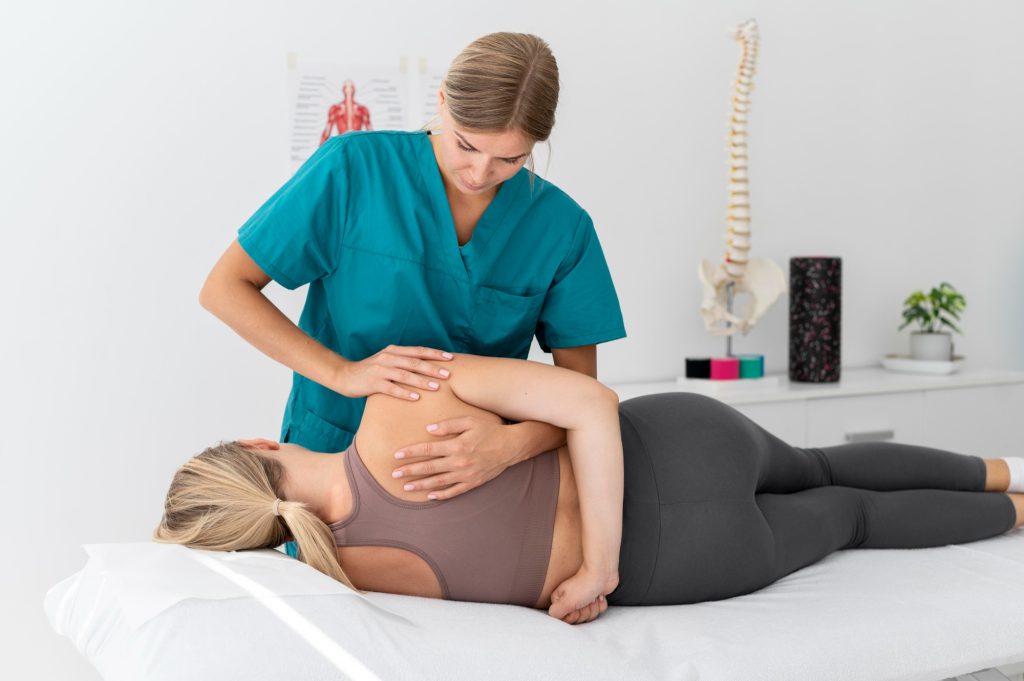Discover whether experiencing back pain after giving birth is a normal occurrence.
Is It Normal to Experience Back Pain After Giving Birth?
Many new moms are surprised to find themselves dealing with back pain after giving birth. You’ve just gone through the incredible experience of bringing a new life into the world, and now you’re dealing with discomfort in your back? It hardly seems fair! But fear not, because postpartum back pain is actually quite common, and there are ways to manage and alleviate the discomfort. In this article, we’ll explore the various aspects of postpartum back pain, from its causes to treatment options and prevention strategies. So, let’s dive in and understand what’s going on with your post-baby back!

Understanding Postpartum Back Pain
Postpartum back pain refers to the discomfort or pain experienced in the back after childbirth. It’s not uncommon for new moms to experience this, and it can range from mild to severe. Understanding why it occurs can help you figure out how to tackle it effectively.
The Anatomy of Postpartum Back Pain
During pregnancy, a woman’s body goes through significant changes to accommodate the growing baby. Hormonal changes loosen the ligaments and joints, preparing the body for childbirth. This, along with the weight gain and shift in the center of gravity, can put extra strain on the back and lead to discomfort.
Let’s dive deeper into the anatomy of postpartum back pain. The ligaments in the pelvic area, such as the sacroiliac ligaments, become more flexible during pregnancy. This increased flexibility allows the pelvis to expand during childbirth, but it also makes the area more vulnerable to strain and instability. Additionally, the weight gain during pregnancy can cause the curvature of the spine to change, leading to increased pressure on the lower back.
Furthermore, the hormonal changes that occur during pregnancy can affect the stability of the joints and ligaments. Relaxin, a hormone released during pregnancy, softens the ligaments in preparation for childbirth. While this is necessary for the birthing process, it can also result in joint instability and contribute to postpartum back pain.
Common Causes of Back Pain After Childbirth
Several factors contribute to postpartum back pain. These include:
- Physical Stress: Giving birth is physically demanding, and the process can strain your back muscles and spine. The exertion and pressure placed on the back during labor can lead to muscle soreness and discomfort in the postpartum period.
- Poor Posture: Taking care of a newborn often involves bending and hunching over frequently, which can strain your back. Whether you’re breastfeeding, changing diapers, or carrying your baby, maintaining proper posture can be challenging. Slouching or hunching over for extended periods can put additional stress on the back muscles and contribute to pain.
- Weight Gain: Pregnancy leads to weight gain, and the additional weight puts pressure on the spine and lower back. The gradual increase in weight over the course of pregnancy can strain the back muscles and lead to discomfort. Even after giving birth, it takes time for the body to adjust and return to its pre-pregnancy state, which can contribute to ongoing back pain.
- Hormonal Changes: Hormones released during pregnancy can cause ligaments and joints to become more relaxed, potentially leading to instability and back pain. As mentioned earlier, relaxin softens the ligaments in preparation for childbirth, but this increased flexibility can also result in joint instability and contribute to postpartum back pain.
It’s important to note that every woman’s experience with postpartum back pain is unique. The severity and duration of the pain can vary, and it’s essential to consult with a healthcare professional for a proper diagnosis and personalized treatment plan. Taking proactive steps to address postpartum back pain can help improve your overall well-being and enhance your ability to care for your newborn.
Identifying Different Types of Postpartum Back Pain
Postpartum back pain can manifest in various forms. Let’s take a closer look at two common types:
Lower Back Pain
Lower back pain is one of the most prevalent types of postpartum back pain. It often occurs due to strain on the muscles and ligaments in the lower back caused by the physical demands of childbirth and caring for a newborn.
During childbirth, the lower back experiences significant stress as the body goes through the intense process of labor. The muscles and ligaments in this area may become strained or stretched, leading to discomfort and pain in the postpartum period. Additionally, the constant bending, lifting, and carrying involved in caring for a newborn can further exacerbate lower back pain.
It is important to note that hormonal changes during pregnancy and childbirth can also contribute to lower back pain. The hormone relaxin, which helps loosen the ligaments in the pelvis to prepare for childbirth, can affect the stability of the lower back as well.
To alleviate lower back pain, it is recommended to practice proper body mechanics, such as using your legs to lift objects instead of your back, maintaining good posture while sitting and standing, and engaging in gentle exercises to strengthen the core muscles that support the lower back.
Upper Back Pain
Upper back pain after giving birth is less common than lower back pain but can still occur. It can be caused by poor posture, especially when breastfeeding, as well as the strain of carrying and cradling your baby.
When breastfeeding, many new mothers tend to hunch forward, rounding their shoulders and straining their upper back muscles. This poor posture can lead to discomfort and pain in the upper back region. Additionally, constantly carrying and cradling a baby can put strain on the upper back muscles, especially if proper body mechanics are not practiced.
It is essential for new mothers to be mindful of their posture while breastfeeding. Using supportive pillows or cushions to bring the baby closer to the breast can help maintain a more upright position and alleviate strain on the upper back. Regular stretching exercises targeting the upper back muscles can also help relieve tension and prevent pain.
Furthermore, it is important to note that stress and fatigue can contribute to both lower and upper back pain in the postpartum period. Lack of sleep, hormonal changes, and the emotional demands of caring for a newborn can all impact the body’s ability to recover and cope with the physical demands of motherhood.
In conclusion, postpartum back pain can vary in its location and intensity. Lower back pain is more common and often results from the physical demands of childbirth and caring for a newborn. Upper back pain, although less prevalent, can be caused by poor posture while breastfeeding and the strain of carrying and cradling a baby. It is crucial for new mothers to practice proper body mechanics, maintain good posture, and engage in gentle exercises to alleviate and prevent postpartum back pain.
The Duration of Postpartum Back Pain
Postpartum back pain can vary in duration, with some experiencing short-term discomfort and others dealing with long-term issues. Let’s explore both scenarios:
Short-Term Back Pain After Childbirth
Short-term back pain typically lasts a few weeks to a few months after giving birth and gradually subsides as your body recovers from the physical stress of childbirth. During this period, it is important to prioritize self-care and take steps to manage the discomfort effectively.
One common cause of short-term postpartum back pain is the strain placed on the muscles and ligaments during pregnancy and delivery. The weight of the growing baby, hormonal changes, and the stretching of the abdominal muscles can all contribute to the discomfort. Additionally, the act of giving birth itself can put stress on the back, especially if there were complications or the need for interventions such as forceps or vacuum extraction.
To alleviate short-term postpartum back pain, it is recommended to practice gentle exercises that target the core and back muscles. Strengthening these muscles can provide support and stability to the spine, reducing pain and promoting healing. Additionally, applying heat or cold packs to the affected area, taking over-the-counter pain relievers (under medical guidance), and using supportive pillows while resting or breastfeeding can all provide relief.
Long-Term Back Pain After Childbirth
In some cases, postpartum back pain may persist for an extended period. This could be due to a variety of factors, including an underlying condition, poor postural habits, or the ongoing physical demands of caring for a baby.
If you are experiencing long-term back pain after childbirth, it is important to seek medical advice to identify and address the underlying cause. A healthcare professional can evaluate your symptoms, conduct a physical examination, and recommend appropriate diagnostic tests if necessary. This will help determine if there are any underlying conditions such as herniated discs, spinal stenosis, or muscle imbalances contributing to the pain.
In addition to medical intervention, making lifestyle modifications can also help manage long-term postpartum back pain. This may involve improving posture while feeding or carrying your baby, using ergonomic baby carriers or strollers, and incorporating regular exercise into your routine to strengthen the back and core muscles. Physical therapy and chiropractic care can also be beneficial in providing targeted treatment and rehabilitation.
Remember, every individual’s experience with postpartum back pain is unique, and the duration and severity can vary. It is essential to listen to your body, seek appropriate medical advice, and take proactive steps to manage and alleviate the discomfort. With time, proper care, and support, postpartum back pain can be effectively addressed, allowing you to fully enjoy the precious moments of motherhood.
Treatment Options for Postpartum Back Pain
If you’re dealing with postpartum back pain, know that there are treatment options available to help alleviate your discomfort. These can be categorized into medical treatments and natural remedies.

Medical Treatments
Your healthcare provider may recommend various medical treatments based on the severity and underlying cause of your back pain. These could include physical therapy, chiropractic adjustments, massage therapy, or even medications in some cases. It’s crucial to consult professionals for personalized advice and guidance.
Natural Remedies
Aside from medical treatments, there are natural remedies you can try at home to manage postpartum back pain. These include gentle exercises, hot or cold packs, practicing good posture, and seeking the support of specialized postpartum yoga or Pilates classes. Always consult with your healthcare provider before starting any new exercise or self-care routine to ensure it is safe and appropriate for your specific situation.
Prevention Strategies for Postpartum Back Pain
Here are a few strategies that can help prevent or minimize the likelihood of experiencing postpartum back pain:
Posture and Lifting Techniques
Paying attention to your posture, both during pregnancy and after childbirth, can make a significant difference in reducing back pain. Practice proper posture while sitting, standing, and lifting objects, especially your baby. Use ergonomic baby gear to support your back and avoid unnecessary strain.
Exercise and Physical Therapy
Engaging in gentle exercises and stretches that specifically target the back muscles can help strengthen and support your spine. Consider joining a postpartum exercise class or working with a physical therapist who specializes in women’s health to develop a safe and effective exercise routine.
Remember, every woman’s postpartum journey is unique, and the severity and duration of back pain can vary. Don’t hesitate to reach out to healthcare professionals for personalized advice and guidance. With the right care and self-care practices, managing postpartum back pain is possible, allowing you to focus on the joyous moments of motherhood without unnecessary discomfort.



